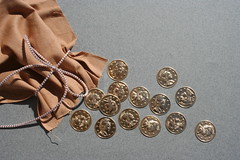In last month’s post on this
blog, Are Keywords Market Shares? I made the case for exploiting more valid and qualified keywords to capture more Web customers. In itself, this seems as basic as having a large store serviced by many doors –i.e., one or more doors per street surrounding the store. Everyone passing by interested in what you have to sell might like to step in and have a look at what you have to offer no matter from what street they’d come in from. Even on the Web, letting potential customers walking by on the sidewalk without noticing your store because it’s lacking a door or a showcase (or a valid keyword) still isn’t a
good idea.

This is what produced the traditional phrase “Location, Location an Location,” well known in the brick & mortar business world. If it were possible, being on every street where actual clients exist and might want to buy reflects that unreachable ideal in the real world, whereas exploiting many keywords allows exactly the same extraordinary opportunity that few exploit, even with cheaper SEO or more expensive PPC eMarketing.
Getting more sales? With What?
So, once valid and qualified Keywords are chosen and properly integrated into a Web site focussing on market shares, what else is needed to actually get more sales?
Ever since the mid ‘90s, marketing specialists, business analysis organizations and anyone else having a formal business training needed answers to predict, control and exploit customer’s behaviour towards the new artificial presence that websites delivered. Basically, words and pictures were all that there was.
Nowadays, much more exists, but these still basic pillars are often traded-in for convenience of having a simplified experience of the web. Because of this, most Web copywriters will like to write as little as possible not to confuse the reader or distract him from the all-important action he must take to buy from, or give out something on a website.
When LESS delivers LESS
This “streamlining” approach applied to words limit the actual value of these Web sites for Search Engine Robots, who are in need of well-coded words as well as word-volumes and density to determine the value, meaning and usefulness of a Web page in opposition to all others on the subject, so to position it somewhere in the infinity of Search Engine Results Pages (SERPs) they must create when people look for stuff to buy.
And besides having to please Search Engines…people want to access exactly, if not only, what they’re looking for.
Now, to solve that problem, ask a graphic artist, a copywriter or a programmer to determine what type of content might be needed to satisfy all types of possible customers potentially looking for a product on a Web page, once it’s discovered through SERPs, if it ever gets discovered with so few words to start with…?
No matter what’s proposed by these service providers, it’s very likely that HIGHLY COMPETITIVE BUSINESS OFFERS won’t be in the lot.
UNIQUE SELLING PROPOSITION FACTORS
In fact, when we’re actually doing window-shopping or more serious product-comparison shopping, we’re able to differentiate between whatever offers we find, even to the point of knowing when we’re spending a bit more than we could, if certain other circumstances were present. Basically, we acknowledge that there’s enough value seen in a Web page to purchase whatever we’re looking for without eternally going on to find a better deal somewhere else.
Too many Web sites don’t value nor post their UNIQUE SELLING PROPOSITION immediately up front for every visitor to see. Web designers, copywriters and even business people think that web customers will “discover” all value-driven attributes attached to a product in consecutive Web pages to finally decide to buy it. They often stretch-out visitor’s patience and clics.
For anyone looking at Visitor’s Bounce Rates (Web visitors leaving a website immediately after arriving) accessible in website statistics, they’d see that people don’t hang around long enough to study, conclude and then act upon their reasoned understanding when they’re purchasing most stuff on the Web. Their first 3-5 second presence on a Web page decides if they’re going to hang around or leave to have a look at another hopefully better Web page or Web site.
In any circumstance, a UNIQUE SELLING PROPOSITION should be out in front in your customer’s face at all times, and in a Web page area that’s not limiting your Search Engine Content, nor its ability to convince Search Engines that your page is great enough to bring back in good SERPs positions. Since Web pages are strategically divided in more than 8 sections by Search Engine Robots, people also divide content posted on Web pages differently, in their own way. Human Pattern Recognition (a.k.a. Heat Maps) and correct SERPs content should always be at the right place, at the right time to get sales going in the shortest possible period of time . Have you read Google Patents Lately?
And you thought 30-Second Elevator Pitches were short!?
That’s where commercial Web copywriters familiar with HUMAN and SEO needs can come in and create all valid contend each Web page visitor would find convincing enough to act as a trigger to induce human sales and better SERPs positions from bots.
Your Website’s Bermuda triangle.
So, over and above extraordinary SEO, a website also needs extraordinary UNIQUE SELLING PROPOSITIONS to get people to buy with confidence, once they’ve found out how to go about it in your website… COSTUMER CONVERSION then becomes your last obstacle to finally solve, circumventing the more than 85% of abandoned sales, forever lost in Website’s Bermuda triangle.
Next Month – Third layer: CUSTOMER CONVERSION FACTORS






